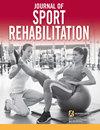Translation, Cross-Cultural Adaptation, and Validation of the Italian Version of the Shoulder Instability-Return to Sport After Injury (SI-RSI) Scale.
IF 1.5
4区 医学
Q3 REHABILITATION
引用次数: 0
Abstract
OBJECTIVE To culturally adapt and validate the Italian version of the Shoulder Instability-Return to Sport after Injury (SI-RSI-I) scale. METHODS The SI-RSI-I was developed by adapting the Anterior Cruciate Ligament-Return to Sport Index-Italian version and replacing the term "knee" with "shoulder." Subsequently, it underwent validation following COSMIN recommendations. The study involved athletic participants who experienced SI. They completed the SI-RSI-I together with other measurement instruments: Western Ontario Shoulder Instability Index, Kerlan-Jobe Orthopedic Clinic Score, EuroQol-5D-5L, and Numeric Pain Rating Scale. The following psychometric properties were investigated: structural validity, internal consistency, test-retest reliability, measurement error, and construct validity. RESULTS The study included 101 participants (age mean [SD] 28.5 [7.4] y; 83 males, 18 females). The SI-RSI-I showed a single-factor structure, excellent internal consistency (α = .935), and excellent test-retest reliability (ICC = .926; 95% CI, .853-.964). The standard error of measurement was 6.1 points, and the minimal detectable change was 17.0 points. Furthermore, SI-RSI-I demonstrated moderate to strong correlations with all reference scales, confirming 8 out of 9 (88.0%) hypotheses, thus establishing satisfactory construct validity. CONCLUSION The SI-RSI-I has demonstrated robust internal consistency, reliability, validity, and feasibility as a valuable scale for assessing psychological readiness to return to sport in Italian athletes with SI.肩关节损伤后不稳定性--恢复运动能力(SI-RSI)量表意大利语版本的翻译、跨文化适应性和验证。
目的对意大利语版的 "肩关节损伤后不稳定性--恢复运动 "量表(SI-RSI-I)进行文化适应性调整和验证。方法通过对意大利语版的 "前十字韧带--恢复运动指数 "进行调整,并用 "肩关节 "取代 "膝关节",开发出 SI-RSI-I 量表。随后,根据 COSMIN 的建议对其进行了验证。这项研究的参与者都是经历过 SI 的运动员。他们与其他测量工具一起完成了 SI-RSI-I 的测量:西安大略省肩关节不稳定性指数、Kerlan-Jobe 骨科诊所评分、EuroQol-5D-5L 和数字疼痛评分量表。研究对以下心理测量特性进行了调查:结构效度、内部一致性、重测信度、测量误差和构架效度。SI-RSI-I 显示出单因素结构、极好的内部一致性(α = .935)和极好的测试-再测可靠性(ICC = .926; 95% CI, .853-.964)。测量的标准误差为 6.1 分,可检测到的最小变化为 17.0 分。此外,SI-RSI-I 与所有参考量表都显示出中等至较强的相关性,证实了 9 个假设中的 8 个(88.0%),从而建立了令人满意的建构效度。
本文章由计算机程序翻译,如有差异,请以英文原文为准。
求助全文
约1分钟内获得全文
求助全文
来源期刊

Journal of Sport Rehabilitation
医学-康复医学
CiteScore
3.20
自引率
5.90%
发文量
143
审稿时长
>12 weeks
期刊介绍:
The Journal of Sport Rehabilitation (JSR) is your source for the latest peer-reviewed research in the field of sport rehabilitation. All members of the sports-medicine team will benefit from the wealth of important information in each issue. JSR is completely devoted to the rehabilitation of sport and exercise injuries, regardless of the age, gender, sport ability, level of fitness, or health status of the participant.
JSR publishes peer-reviewed original research, systematic reviews/meta-analyses, critically appraised topics (CATs), case studies/series, and technical reports that directly affect the management and rehabilitation of injuries incurred during sport-related activities, irrespective of the individual’s age, gender, sport ability, level of fitness, or health status. The journal is intended to provide an international, multidisciplinary forum to serve the needs of all members of the sports medicine team, including athletic trainers/therapists, sport physical therapists/physiotherapists, sports medicine physicians, and other health care and medical professionals.
 求助内容:
求助内容: 应助结果提醒方式:
应助结果提醒方式:


